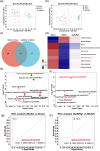Synergism of salvianolic acid B and ginsenoside Rg1 magnifies the therapeutic potency against ischemic stroke
- PMID: 39292959
- PMCID: PMC11424057
- DOI: 10.1097/WNR.0000000000002099
Synergism of salvianolic acid B and ginsenoside Rg1 magnifies the therapeutic potency against ischemic stroke
Abstract
Even though considerable progress has been made to reduce insult, ischemic stroke is still a significant cause of mortality and morbidity in the world, and new therapeutic strategies are urgently needed. In the present study, the magnesium salt of salvianolic acid B (SalB) and ginsenoside Rg1 (Rg1) combination as a multicomponent strategy against stroke was evaluated. The synergistic effect of Sa1B and Rg1 was evaluated by Bliss independence analysis on the middle cerebral artery occlusion model. The infarct volume, neuroethology, cerebral structure, and neurocyte number were evaluated by 3,5-triphenyltetrazolium chloride staining, Longa score, Garcia score, hematoxylin-eosin staining, and Nissl staining, respectively. Metabolomics was used to search for potential biomarkers and explore the mechanism of Sa1B/Rg1. First, the superior effects of SalB/Rg1 than SalB or Rg1 at the same dose were evaluated. Compared with SalB ( P < 0.001) or Rg1 ( P < 0.01), SalB/Rg1 significantly decreased infarct volume through 3,5-triphenyltetrazolium chloride staining and protected the structural integrity of cortex and striatum. The superior effect of SalB/Rg1 on neurological behavior was also detected compared with SalB or Rg1 significantly. Accompanying behavioral improvement, a considerable increase of SalB/Rg1 on neurons detected by Nissl staining was found on the cortex compared with SalB ( P < 0.05) or Rg1 ( P < 0.01). Second, the synergistic effect between SalB and Rg1 was strictly verified by Bliss independence analysis ( P < 0.01) based on infarct volume. Finally, alleviation of cerebral metabolic disorders may be the possible mechanism of SalB/Rg1. Our study provided a multicomponent strategy against ischemic stroke, with not only dose reduction but also improved efficacy relative to single agents.
Copyright © 2024 The Author(s). Published by Wolters Kluwer Health, Inc.
Conflict of interest statement
There are no conflicts of interest.
Figures






References
-
- Campbell BCV, Khatri P. Stroke. Lancet. 2020; 396:129–142. - PubMed
-
- Hill MD, Martin RH, Mikulis D, Wong JH, Silver FL, Terbrugge KG, et al. ; ENACT Trial Investigators. Safety and efficacy of NA-1 in patients with iatrogenic stroke after endovascular aneurysm repair (ENACT): a phase 2, randomised, double-blind, placebo-controlled trial. Lancet Neurol. 2012; 11:942–950. - PubMed
-
- Malhotra K, Chang JJ, Khunger A, Blacker D, Switzer JA, Goyal N, et al. . Minocycline for acute stroke treatment: a systematic review and meta-analysis of randomized clinical trials. J Neurol. 2018; 265:1871–1879. - PubMed
MeSH terms
Substances
Grants and funding
LinkOut - more resources
Full Text Sources
Medical

